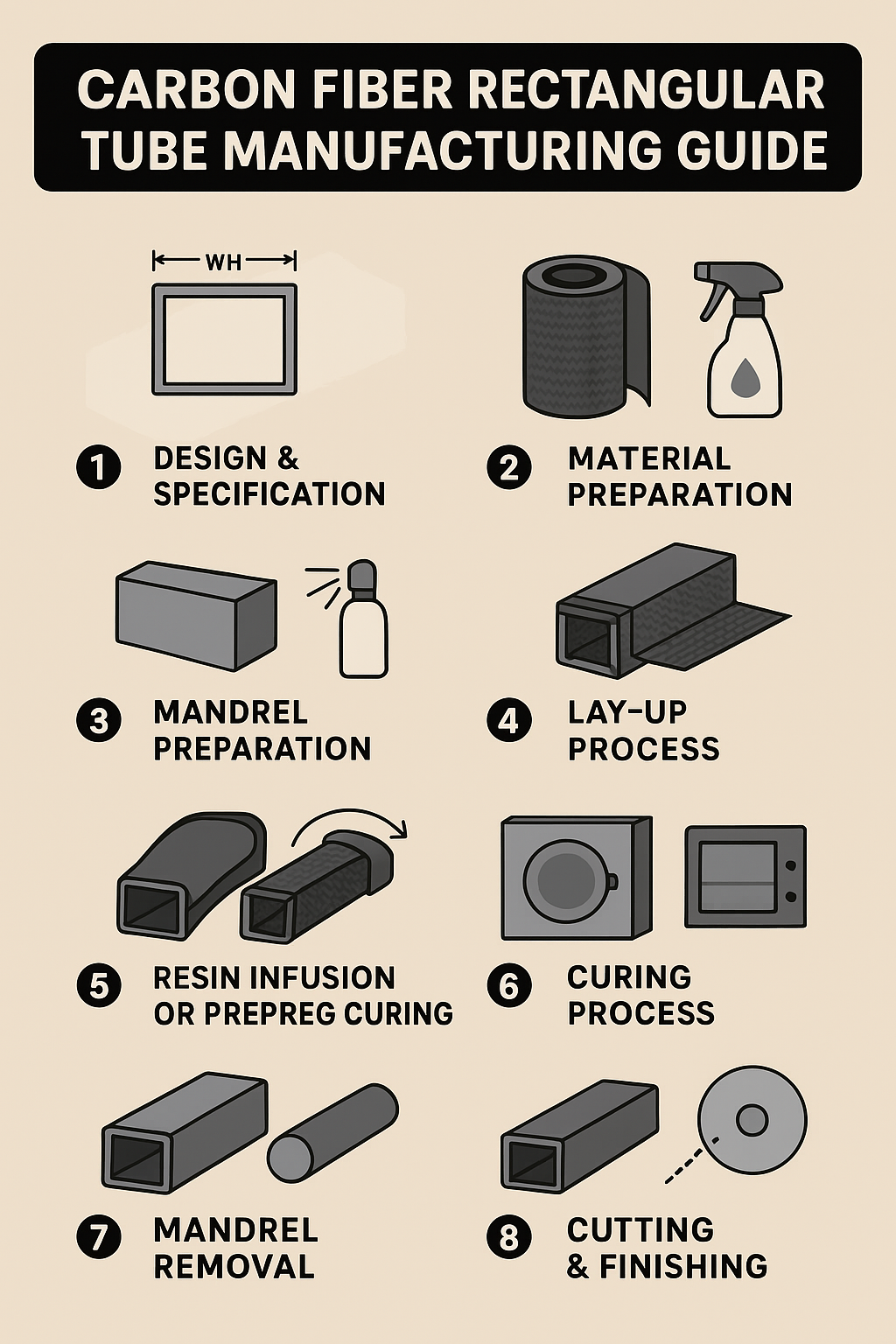Introduction
In modern engineering and production, Carbon Fiber Rectangular Tube Manufacturing Guide has become an essential fabric way to its exquisite electricity-to-weight ratio, corrosion resistance, and glossy look. Whether or not you’re in aerospace, automotive, robotics, sports gadget, or structure, understanding how those tubes are made permits you to pick out the proper material and make certain ideal overall performance in your undertaking.
This carbon fiber rectangular tube manufacturing guide covers the step-with the aid of-step manufacturing system, the substances involved, benefits, programs, and best management measures — all defined in easy phrases.
What is a Carbon Fiber Rectangular Tube?
A carbon fiber rectangular tube is a hollow structural issue with a square cross-section crafted from layers of carbon fiber and resin.
These tubes are:
- Lightweight yet stronger than steel by weight
- Resistant to corrosion and chemicals
- Designed for high stiffness and minimal flex
- Useful for structural and aesthetic applications
Types of Carbon Fiber Rectangular Tubes
There are several variations depending on the manufacturing process and fiber orientation.
- Pultruded Tubes
- Made by pulling carbon fiber through resin and a heated die.
- Strongest along the tube’s length.
- Best for straight-load applications.
- Roll-Wrapped Tubes
- Strong in multiple directions.
- Made by wrapping carbon fiber sheets around a mandrel.
- Great for bending, torsion, and complicated load instances.
- Custom-Molded Tubes
- Made with special molds for specific shapes.
- Allows integration with other components.
Materials Used in Carbon Fiber Rectangular Tube Manufacturing
The pleasant of the tube relies upon at the substances used.
- Carbon Fiber Prepreg
(Pre-impregnated carbon fiber with resin) - Epoxy Resin
(Provides bonding and environmental protection) - Mandrels or Molds
(Determines the shape of the tube) - Release Agents
(Prevent sticking to molds) - Protective Coatings
(For UV and abrasion resistance)
Step-through-Step manufacturing manner
Right here’s a simplified breakdown of how carbon fiber rectangular tubes are made.
1. Design & Specification
- Determine tube dimensions (width, height, wall thickness).
- Determine fiber orientation based on load requirements.
- Pick out production technique (pultrusion, roll-wrapping, or molding).
2. Material Preparation
- Pick carbon fiber type (wellknown modulus, intermediate modulus, or excessive modulus).
- Prepare resin device (normally epoxy).
- Reduce prepreg sheets or dry carbon fiber to length.
3. Mandrel Preparation
- Create a rectangular mandrel (metallic or composite).
- Observe launch agent to prevent sticking.
4. Lay-Up Process
- Wrap carbon fiber layers around the mandrel in the required orientation:
- 0° fibers for axial strength.
- 90° fibers for lateral strength.
- ±45° fibers for torsional resistance.
- Ensure even tension and alignment to avoid defects.
5. Resin Infusion or Prepreg Curing
- For Prepreg: Place the wrapped mandrel in an autoclave or oven.
- For Resin Infusion: Use vacuum bagging to pull resin into dry fibers.
- Maintain proper temperature and pressure for curing.
6. Curing Process
- Cure in an autoclave (most precise method) or oven.
- Curing times vary from 1–4 hours depending on resin.
7. Mandrel Removal
- After curing, remove the mandrel carefully.
- For collapsible mandrels, this is easier; for solid mandrels, a release mechanism is used.
8. Reducing & completing
- Reduce tubes to the desired duration the use of a diamond-covered saw blade.
- Sand edges and apply a protective clear coat.
Quality Control in Manufacturing
Quality control is vital for safety and performance.
- High-quality manage is critical for protection and overall performance.
- Visual Inspection: look for floor defects or wrinkles.
- Dimensional tests: make sure wall thickness and dimensions meet design.
- Non-damaging checking out (NDT): Use ultrasound or X-ray to come across inner flaws.
Applications of Carbon Fiber Rectangular Tubes
These tubes are used across industries:
- Aerospace: aircraft additives, UAV frames.
- Automotive: Chassis elements, body frames.
- Robotics: lightweight arm systems.
- Sports activities equipment: Bicycles, ski frames.
- Architecture: ornamental and load-bearing elements.
Maintenance Tips for Carbon Fiber Rectangular Tubes
- Keep away from sharp impacts that could purpose cracks.
- Keep in dry, cool environments.
- Use UV-resistant coating for outdoor publicity.
- Look into it periodically for delamination or damage.
FAQs
Q1: Can carbon fiber rectangular tubes be bent?
Not easily. They are designed for rigidity. immoderate bending may reason cracks.
Q2: How long do they last?
With proper care, they could last decades without losing electricity.
Q3: Are they more expensive than steel tubes?
Yes, however, their performance benefits frequently outweigh the value.
Q4: Can I drill holes in carbon fiber tubes?
Yes, however, use a diamond or carbide drill bit and avoid immoderate force.
Q5: Which manufacturing approach is fine?
Pultrusion for instantly power, roll-wrapping for multi-directional electricity.
Conclusion
Carbon fiber rectangular tubes are a game-changer in present-day production — providing electricity, lightweight overall performance, and durability unrivaled by most substances.
with the aid of know-how the manufacturing method, from design to great manage, you can make informed decisions whilst deciding on or producing those components to your tasks.
if your goal is light-weight strength with top rate aesthetics, carbon fiber rectangular tubes are an investment really worth making.



